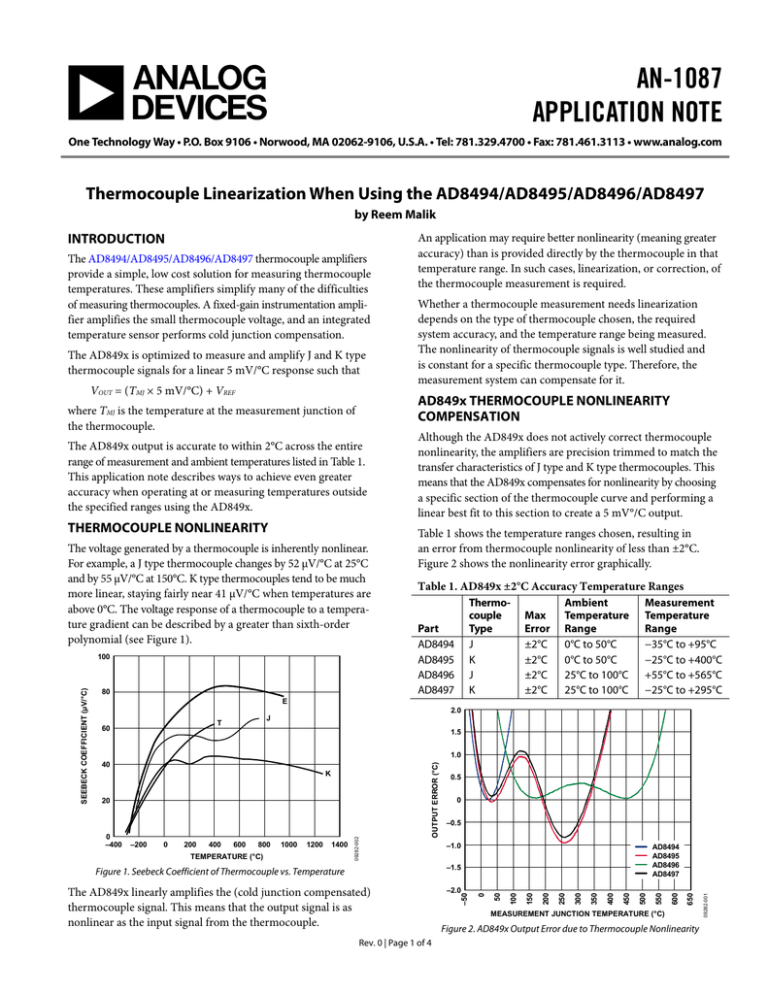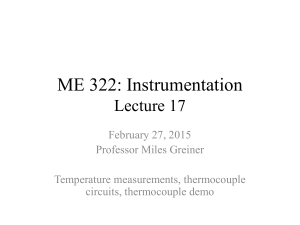AN-1087 APPLICATION NOTE
advertisement

AN-1087 APPLICATION NOTE One Technology Way • P.O. Box 9106 • Norwood, MA 02062-9106, U.S.A. • Tel: 781.329.4700 • Fax: 781.461.3113 • www.analog.com Thermocouple Linearization When Using the AD8494/AD8495/AD8496/AD8497 by Reem Malik INTRODUCTION The AD8494/AD8495/AD8496/AD8497 thermocouple amplifiers provide a simple, low cost solution for measuring thermocouple temperatures. These amplifiers simplify many of the difficulties of measuring thermocouples. A fixed-gain instrumentation amplifier amplifies the small thermocouple voltage, and an integrated temperature sensor performs cold junction compensation. The AD849x is optimized to measure and amplify J and K type thermocouple signals for a linear 5 mV/°C response such that VOUT = (TMJ × 5 mV/°C) + VREF Whether a thermocouple measurement needs linearization depends on the type of thermocouple chosen, the required system accuracy, and the temperature range being measured. The nonlinearity of thermocouple signals is well studied and is constant for a specific thermocouple type. Therefore, the measurement system can compensate for it. AD849x THERMOCOUPLE NONLINEARITY COMPENSATION where TMJ is the temperature at the measurement junction of the thermocouple. The AD849x output is accurate to within 2°C across the entire range of measurement and ambient temperatures listed in Table 1. This application note describes ways to achieve even greater accuracy when operating at or measuring temperatures outside the specified ranges using the AD849x. THERMOCOUPLE NONLINEARITY The voltage generated by a thermocouple is inherently nonlinear. For example, a J type thermocouple changes by 52 μV/°C at 25°C and by 55 μV/°C at 150°C. K type thermocouples tend to be much more linear, staying fairly near 41 μV/°C when temperatures are above 0°C. The voltage response of a thermocouple to a temperature gradient can be described by a greater than sixth-order polynomial (see Figure 1). 100 80 Although the AD849x does not actively correct thermocouple nonlinearity, the amplifiers are precision trimmed to match the transfer characteristics of J type and K type thermocouples. This means that the AD849x compensates for nonlinearity by choosing a specific section of the thermocouple curve and performing a linear best fit to this section to create a 5 mV°/C output. Table 1 shows the temperature ranges chosen, resulting in an error from thermocouple nonlinearity of less than ±2°C. Figure 2 shows the nonlinearity error graphically. Table 1. AD849x ±2°C Accuracy Temperature Ranges Thermocouple Type J K J K Part AD8494 AD8495 AD8496 AD8497 Max Error ±2°C ±2°C ±2°C ±2°C Ambient Temperature Range 0°C to 50°C 0°C to 50°C 25°C to 100°C 25°C to 100°C Measurement Temperature Range −35°C to +95°C −25°C to +400°C +55°C to +565°C −25°C to +295°C E 2.0 J T 60 1.5 –1.0 Rev. 0 | Page 1 of 4 MEASUREMENT JUNCTION TEMPERATURE (°C) Figure 2. AD849x Output Error due to Thermocouple Nonlinearity 09282-001 –2.0 600 The AD849x linearly amplifies the (cold junction compensated) thermocouple signal. This means that the output signal is as nonlinear as the input signal from the thermocouple. 650 –1.5 550 Figure 1. Seebeck Coefficient of Thermocouple vs. Temperature AD8494 AD8495 AD8496 AD8497 500 1400 450 1200 400 1000 350 800 300 600 250 400 TEMPERATURE (°C) 200 200 150 0 100 –200 –0.5 0 0 –400 0 50 20 0.5 –50 K OUTPUT ERROR (°C) 1.0 40 09282-002 SEEBECK COEFFICIENT (µV/°C) An application may require better nonlinearity (meaning greater accuracy) than is provided directly by the thermocouple in that temperature range. In such cases, linearization, or correction, of the thermocouple measurement is required. AN-1087 Application Note Each part in the AD849x family is precision trimmed to optimize a linear operating range for a specific thermocouple type and for specific measurement and ambient temperature ranges. The following three parameters are trimmed to achieve a 5 mV/°C output with minimal errors: • • • Gain of the amplifier Offset of the amplifier (error voltage at 0°C to achieve 125 mV at 25°C) Scale factor of the temperature sensor/cold junction compensator VTC = fNIST (TMJ − 0) − fNIST (TRJ − 0) Output values for intermediate temperatures can be interpolated or calculated using the AD849x output equations and the NIST thermoelectric voltage tables referred to 0°C. For the AD8494, the equation is as follows: VTC ןTMJ – TRJ = (TMJ − 0) − (TRJ − 0) TMJ = fNIST ((VOUT − VREF)/96.7) The following transfer function should be used to determine the actual thermocouple voltages being measured by the AD849x (see Table 2 for specific values for each part). For the AD8495, the equation is as follows: TMJ = fNIST ((VOUT − VREF − 1.25 mV)/122.4) VOUT − (TRJ × CJC ) − VOFFSET − VREF For the AD8496, the equation is as follows: Gain TMJ = fNIST ((VOUT − VREF − 20.2 mV)/90.35) where: CJC is the cold junction compensation scale factor. VOFFSET is the error voltage at 0°C to achieve 125 mV at 25°C. VREF is the user input voltage. Gain is the gain of the amplifier. For the AD8497, the equation is as follows: TMJ = fNIST ((VOUT − VREF + 0.98 mV)/122.4) Table 2. Transfer Function Values for the AD8494, AD8495, AD8496, and AD8497 Part AD8494 AD8495 AD8496 AD8497 The second method is to use the following equations, where TMJ is the temperature at the thermocouple measurement junction, and fNIST is a millivolt-to-temperature function based on the standard lookup tables or on equations published by the National Institute of Standards and Technology (thermocouple databases can be found at http://srdata.nist.gov/its90/main). Recall that VTC ןTMJ − TRJ, such that The thermocouple voltage, VTC, is a function of the thermocouple type, the measurement junction temperature (TMJ), and the reference junction temperature (TRJ). VTC = NIST Thermoelectric Voltage Lookup Tables Gain 96.7 122.4 90.35 122.4 CJC Factor (mV/°C) 5 4.95 4.8 5.0392 Offset (mV) 0 1.25 20.2 −0.98 LINEARITY CORRECTION ALGORITHMS Using the same example as for the first method (an AD8495 at room temperature with a grounded reference pin connected to a K type thermocouple that reads 1 V), the correction procedure is as follows: TMJ = fNIST ((1 V − 1.25 mV)/122.4) = fNIST (8.158 mV) 1. 2. Thermocouple nonlinearity is typically corrected with a microcontroller in the digital domain. One of two correction algorithms can be used. AD849x Output Lookup Table The first method is to use Table 3, which lists the ideal AD849x output voltages as a function of the temperature for J type and K type thermocouples with the specified junction temperatures. For example, an AD8495 at room temperature (25°C) with a grounded reference pin connected to a K type thermocouple outputs 1 V. Using the 5 mV/°C transfer function, 1 V represents 200°C. For greater accuracy, the user must calculate the temperature that corresponds to the 1 V output as follows: 1. 2. Table 3 indicates that at a measurement junction temperature of 200°C, the actual AD8495 output is 0.999 V, and at a measurement junction temperature of 220°C, it is 1.097 V. Linear extrapolation between these two points yields an answer of 200.2°C at 1 V. Rev. 0 | Page 2 of 4 Consulting a standard K type thermocouple table indicates that at a measurement junction temperature of 200°C, the thermoelectric voltage of the thermocouple is 8.138 mV, and at a measurement junction temperature of 201°C, the thermoelectric voltage is 8.178 mV. Linear extrapolation yields a final answer of 200.5°C. Application Note AN-1087 Table 3. Actual AD849x Results Reflecting Thermocouple Nonlinearity Measurement Junction Temperature (°C) −260 −240 −220 −200 −180 −160 −140 −120 −100 −80 −60 −40 −20 0 20 25 40 60 80 100 120 140 160 180 200 220 240 260 280 300 320 340 360 380 400 420 440 460 480 500 520 540 560 580 600 620 640 660 680 AD8494/AD8495 Output, TA = TRJ = 25°C Ideal Output (V) Actual Output (V) AD8494/ AD8494 Output AD8495 Output AD8495 with J Type with K Type −1.3 −0.786 −1.2 −0.774 −1.1 −0.751 −1 −0.719 −0.9 −0.714 −0.677 −0.8 −0.658 −0.627 −0.7 −0.594 −0.569 −0.6 −0.523 −0.504 −0.5 −0.446 −0.432 −0.4 −0.365 −0.355 −0.3 −0.278 −0.272 −0.2 −0.188 −0.184 −0.1 −0.095 −0.093 0 0.002 0.003 0.1 0.100 0.100 0.125 0.125 0.125 0.2 0.201 0.200 0.3 0.303 0.301 0.4 0.406 0.402 0.5 0.511 0.504 0.6 0.617 0.605 0.7 0.723 0.705 0.8 0.829 0.803 0.9 0.937 0.901 1 1.044 0.999 1.1 1.151 1.097 1.2 1.259 1.196 1.3 1.366 1.295 1.4 1.473 1.396 1.5 1.580 1.497 1.6 1.687 1.599 1.7 1.794 1.701 1.8 1.901 1.803 1.9 2.008 1.906 2 2.114 2.010 2.1 2.221 2.113 2.2 2.328 2.217 2.3 2.435 2.321 2.4 2.542 2.425 2.5 2.650 2.529 2.6 2.759 2.634 2.7 2.868 2.738 2.8 2.979 2.843 2.9 3.090 2.947 3 3.203 3.051 3.1 3.316 3.155 3.2 3.431 3.259 3.3 3.548 3.362 3.4 3.666 3.465 Rev. 0 | Page 3 of 4 AD8496/AD8497 Output, TA = TRJ = 60° Ideal Output (V) Actual Output (V) AD8496/ AD8496 Output AD8497 Output AD8497 with J Type with K Type −1.3 −0.785 −1.2 −0.773 −1.1 −0.751 −1 −0.718 −0.9 −0.642 −0.676 −0.8 −0.590 −0.626 −0.7 −0.530 −0.568 −0.6 −0.464 −0.503 −0.5 −0.392 −0.432 −0.4 −0.315 −0.354 −0.3 −0.235 −0.271 −0.2 −0.150 −0.184 −0.1 −0.063 −0.092 0 0.027 0.003 0.1 0.119 0.101 0.125 0.142 0.126 0.2 0.213 0.200 0.3 0.308 0.301 0.4 0.405 0.403 0.5 0.503 0.505 0.6 0.601 0.605 0.7 0.701 0.705 0.8 0.800 0.804 0.9 0.900 0.902 1 1.001 0.999 1.1 1.101 1.097 1.2 1.201 1.196 1.3 1.302 1.296 1.4 1.402 1.396 1.5 1.502 1.498 1.6 1.602 1.599 1.7 1.702 1.701 1.8 1.801 1.804 1.9 1.901 1.907 2 2.001 2.010 2.1 2.100 2.114 2.2 2.200 2.218 2.3 2.300 2.322 2.4 2.401 2.426 2.5 2.502 2.530 2.6 2.603 2.634 2.7 2.705 2.739 2.8 2.808 2.843 2.9 2.912 2.948 3 3.017 3.052 3.1 3.124 3.156 3.2 3.231 3.259 3.3 3.340 3.363 3.4 3.451 3.466 AN-1087 Measurement Junction Temperature (°C) 700 720 740 760 780 800 820 840 860 880 900 920 940 960 980 1000 1020 1040 1060 1080 1100 1120 1140 1160 1180 1200 1220 1240 1260 1280 1300 1320 1340 1360 1380 Application Note AD8494/AD8495 Output, TA = TRJ = 25°C Ideal Output (V) Actual Output (V) AD8494/ AD8494 Output AD8495 Output AD8495 with J Type with K Type 3.5 3.786 3.568 3.6 3.906 3.670 3.7 4.029 3.772 3.8 4.152 3.874 3.9 4.276 3.975 4 4.401 4.076 4.1 4.526 4.176 4.2 4.650 4.275 4.3 4.774 4.374 4.4 4.897 4.473 4.5 5.018 4.571 4.6 5.138 4.669 4.7 5.257 4.766 4.8 5.374 4.863 4.9 5.490 4.959 5 5.606 5.055 5.1 5.720 5.150 5.2 5.833 5.245 5.3 5.946 5.339 5.4 6.058 5.432 5.5 6.170 5.525 5.6 6.282 5.617 5.7 6.394 5.709 5.8 6.505 5.800 5.9 6.616 5.891 6 6.727 5.980 6.1 6.069 6.2 6.158 6.3 6.245 6.4 6.332 6.5 6.418 6.6 6.503 6.7 6.587 6.8 6.671 6.9 6.754 ©2010 Analog Devices, Inc. All rights reserved. Trademarks and registered trademarks are the property of their respective owners. AN09282-0-8/10(0) Rev. 0 | Page 4 of 4 AD8496/AD8497 Output, TA = TRJ = 60° Ideal Output (V) Actual Output (V) AD8496/ AD8496 Output AD8497 Output AD8497 with J Type with K Type 3.5 3.562 3.569 3.6 3.675 3.671 3.7 3.789 3.773 3.8 3.904 3.874 3.9 4.020 3.976 4 4.137 4.076 4.1 4.254 4.176 4.2 4.370 4.276 4.3 4.486 4.375 4.4 4.600 4.474 4.5 4.714 4.572 4.6 4.826 4.670 4.7 4.937 4.767 4.8 5.047 4.863 4.9 5.155 4.960 5 5.263 5.055 5.1 5.369 5.151 5.2 5.475 5.245 5.3 5.581 5.339 5.4 5.686 5.433 5.5 5.790 5.526 5.6 5.895 5.618 5.7 5.999 5.710 5.8 6.103 5.801 5.9 6.207 5.891 6 6.311 5.981 6.1 6.070 6.2 6.158 6.3 6.246 6.4 6.332 6.5 6.418 6.6 6.503 6.7 6.588 6.8 6.671 6.9 6.754






